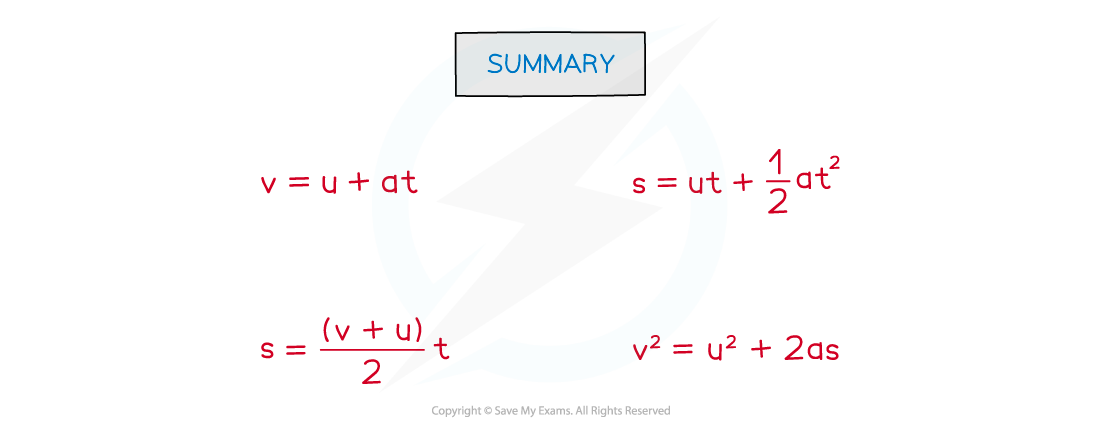Equations of Motion (Edexcel International AS Physics) : Revision Note
Equations of Motion
The kinematic equations of motion are a set of four equations which can describe any object moving with constant acceleration
They are often referred to as the 'suvat' equations due to the variables they include
These are:
s = displacement (m)
u = initial velocity (m s−1)
v = final velocity (m s−1)
a = acceleration (m s−2)
t = time interval (s)
The four SUVAT equations are:

These are all given on the data sheet
All the variables, apart from time t, are vector quantities
This means they can either be positive or negative depending on their direction
Mastering the SUVAT Equations
The SUVAT equations are always used when acceleration is constant, but not zero
This is indicated in questions by
An explicit statement that an object is 'constantly accelerating' or 'constantly decelerating', or words to that effect
A description of an object in freefall where either 'air resistance can be ignored' or 'air resistance is negligible'
A statement that an accelerating or decelerating force is constant, since F = ma, constant force → constant acceleration
Questions may appear to be missing some information, this should be checked before starting to calculate
Objects in motion often start or end at rest, making either u or v = zero
Objects in freefall have a constant acceleration of 9.81 m s−2
When an object is slowing down it has a negative value for acceleration, this must be included in the calculation
Objects thrown or shot upwards also have negative acceleration (since they are slowing down as they ascend) and reach a final velocity of zero at the top of their path
Worked Example
A pilot is landing a small aircraft. The airstrip is only 450 m long and the aircraft decelerates from 40 m s−1 at a constant rate of 2 m s−2.
Determine if the plane will stop before it reaches the end of the runway.
Answer:
Step 1: List the known values
Length of the runway, smax = 450 m (this is the maximum value of displacement)
Initial velocity, u = 40 m s−1
Final velocity, v = 0 m s−1 (since the plane will stop)
Acceleration, a = − 2 m s−2 (the negative sign indicates slowing down)
Step 2: Identify the missing values (the unknown answer and the one not given)
Known quantities: u, v and a
Unknown quantity: displacement, s
Time, t is not required in this question
Step 3: Choose the correct SUVAT equation and rearrange it
The SUVAT equation which contains u, v, a and s and omits t is:
v2 = u2 + 2as
Rearrange to make s the subject:
Step 4: Substitute the values into the equation and calculate s
= 400 m
Step 5: Write the full answer to the question
The plane stops after 400 m, which is 50 m before the end of the runway
Note: In this solution, the negative value produced by v2 − u2 is cancelled out by the negative value for acceleration, giving a positive value for displacement
Worked Example
A rocket is launched vertically, using motors which give it a constant vertical acceleration of 6.5 m s−2 for 30 s before switching off.
At the point when the motors switch off, calculate:
a) The velocity of the rocket
b) The height of the rocket above the launchpad
Answer:
Part (a)
Step 1: List the known values
Initial velocity, u = 0 m s−1
Acceleration, a = 6.5 m s−2 (the positive sign indicates the speed is increasing due to the motor)
Time, t = 30 s
Step 2: Identify the missing values (the unknown answer and the one not given)
Known quantities: u, a, t
Unknown quantity: final velocity, v
Displacement, s, is not required in this question
Step 3: Choose the correct SUVAT equation
The SUVAT equation which omits displacement, s, is:
v = u + at
Step 4: Substitute the values into the equation and calculate
v = 0 + (6.5 × 30) = 195 m s−1
Step 5: Write the full answer to the question, taking care to check significant figures
The final velocity, v, at 30 s is 200 m s−1 (2 s.f.)
Part (b)
Step 1: List the known values
Initial velocity, u = 0 m s−1
Acceleration, a = 6.5 m s−2
Time, t = 30 s
Final velocity, v = 195 m s−1
Step 2: Identify the missing values (the unknown answer and the one not given)
Known quantities: u, a, t, and v (from part a)
Unknown quantity: final displacement, s
All the SUVAT values are available in this case, but since v was calculated, first look for an equation that doesn't use it (in case of mistakes)
Step 3: Choose the correct SUVAT equation
The SUVAT equation which omits velocity is:
s = ut + at2
Step 4: Substitute the values into the equation and calculate s
s = (0 × 30) + (6.5 × 302) = 2925 m
Step 5: Write the full answer to the question, taking care to check significant figures
The height, s, above the launchpad is 2900 m (2 s.f)
Examiner Tips and Tricks
SUVAT questions are popular with examiners, who will find all sorts of ways to set these problems. The trick is practice.
Learn the four equations (even though you are given them) so that you can easily pick the one you need. With lots of practice you will see that often the problem can be simplified, especially when the initial or final velocity is zero.
Finally, never cut corners with these solutions! It's common for questions to have 5-6 marks available for a long calculation. Your job is to write down every step so that the examiner can award marks for as many elements of your answer as possible.

You've read 0 of your 5 free revision notes this week
Sign up now. It’s free!
Did this page help you?
